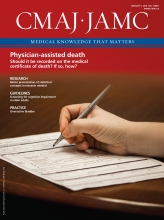A survey of clinicians
Physicians understand the results of meta-analyses better when they are expressed as dichotomous outcomes than when they are expressed as continuous measures. Johnston and colleagues surveyed 531 physicians from eight countries and compared six ways of presenting the results from meta-analyses. Clinicians should be trained to understand the magnitude of effect better, they suggest. See Research, page 25

Statistical interpretation is difficult for researchers as well as clinicians. Education has not been effective in improving statistical knowledge and interpretation among clinicians. More accessible language and visual displays may be needed to make statistical findings from meta-analyses more comprehensible to clinicians. See Commentary, page 11
Disparities in preterm birth
Relative disparities in preterm birth and very preterm birth between black and white women were similar in magnitude in Canada and the United States. The authors compared rates of preterm and very preterm birth using data for 5 million non-Hispanic white and black women in the US and 91 000 non-Hispanic women in Canada, adjusting for available covariates. These results do not support the notion that Canada’s different history, commitment to universal health coverage and more egalitarian society have led to reduced adverse outcomes among black women, suggest the authors. See Research, page E19
Previous studies have compared trends in perinatal outcomes between the US and Canada, but race and ethnicity were not featured. A new record-linkage study has enabled such a comparison. It seems that, although preterm birth rates are lower in Canada for women of both black and white race, black women in Canada and the US have a similarly increased risk of delivering a preterm infant. What remains a mystery is if this phenomenon has its origins in the social, educational, occupational and economic circumstances that women face before and during their pregnancies, or if it is underpinned by some inherent difference. See Commentary, page 13

Screening for cogitive impairment
As people age, changes to the structure and the function of the brain may result in cognitive decline. These changes, however, do not equally affect all cognitive domains or all people. Should we screen asymptomatic patients for cognitive impairment? In this evidence-based guideline, the Canadian Task Force on Preventive Health Care recommends that we don’t, and why not. See Guideline, page 37
In this linked commentary, the authors point out that the guideline serves as an important reminder that we are lagging in our response to an imminent dementia epidemic. They argue that more research is needed before a screening program could be justified. See Commentary, page 15
PAD: completing the death certificate

Physician-assisted death will be legal in Canada in 2016. Physicians need to know whether and, if so, how to record physician-assisted death on medical certificates of death. Downie and Oliver discuss the best approach by examining current practice and best principles. See Analysis, page 49
Overactive bladder
A healthy 53-year-old woman has a one-year history of urinary frequency, associated with strong urges to void and urge incontinence. What diagnoses should be considered? Are any investigations needed, or can the diagnosis be made on the basis of history and physical examination? The authors address these questions and others. See Decision, page 59
Trigger finger

This affects 2% to 3% of adults and up to 10% of those with diabetes. Corticosteroid injection is effective in most patients, but recurrence is common. Some patients may require definitive surgical treatment, either open or percutaneous release, say Ballard and Kozlow. See Five things to know about …, page 61
Intra-arterial thrombectomy
An 87-year-old woman with severe stroke underwent intra-arterial thrombectomy with a stent-retriever device, combined with intravenous tissue plasminogen activator, after presenting within three hours of stroke onset. She was discharged 12 days later with minimal neurologic deficits. Researchers consider this procedure a major breakthrough in the management of stroke, say Khan and Patro. See Clinical images, page 62











